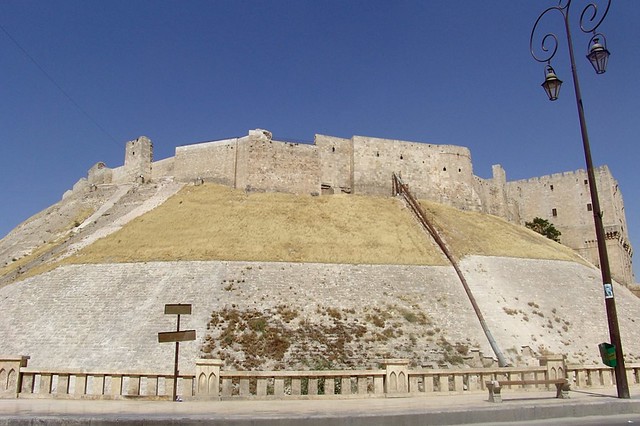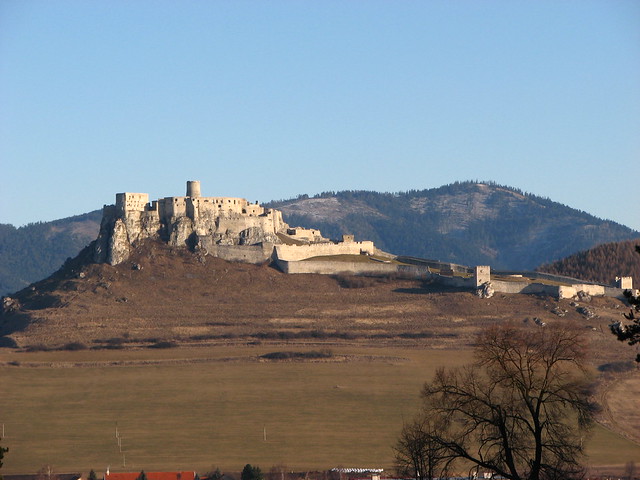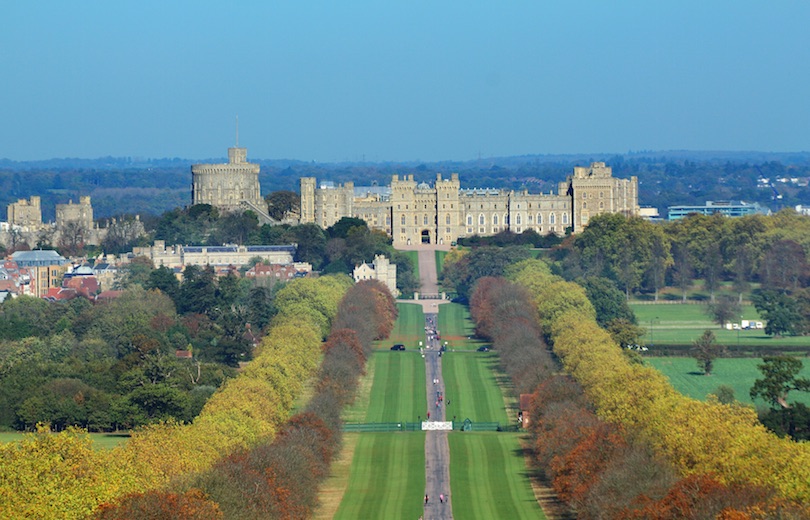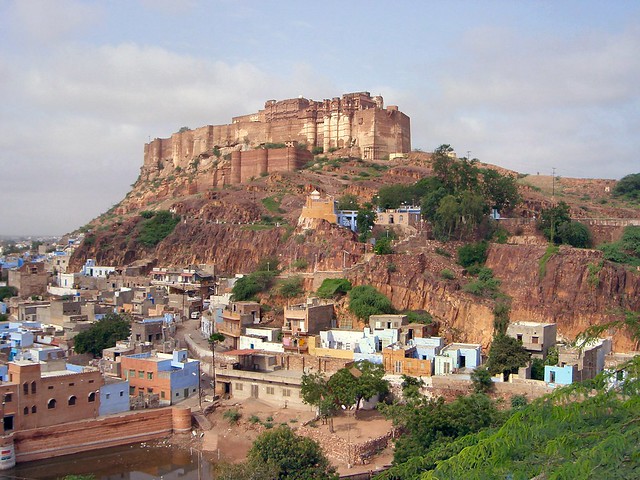Finding the largest castle in the world is not as straightforward as it might sound. First, although commonly defined as “a defensive structure built as a residence for a ruler or nobleman” it isn’t always clear what a castle really is. Most people would agree that the Moscow Kremlin is not a castle but how about the fortresses in India and Japan?
Second, what should be used as a measure of size and how to determine this? According to the Guinness Book of World Records, Prague Castle is the biggest castle complex while Wikipedia describes Windsor Castle as the largest inhabited castle.
10. Edinburgh Castle (35,737 square meters)

Situated on an extinct volcanic crag, Edinburgh castle dominates the skyline of the city of Edinburgh in Scotland. Few of the present buildings pre-date the 16th century. The notable exception is St Margaret’s Chapel, the oldest surviving building in Edinburgh, which dates from the early 12th century.
9. Citadel of Aleppo (39,804)

The Aleppo Citadel is one of the oldest castles in the world. It stands on 50 meter high hill in the center of Aleppo, Syria. Usage of the hill dates back at least to the middle of the 3rd millennium BC. Subsequently occupied by many civilizations including the Greeks, Byzantines, Ayyubids and Mamluks, the majority of the construction as it stands today dates from the 13th century.
8. Himeji Castle (41,468)

Himeji Castle is generally considered Japan’s most beautiful castle and is one of the few that has escaped the ravages of civil war, earthquakes and bombings. A fort was first built on the current site in the 14th century and gradually enlarged over the centuries. The castle complex, as it survives today, was completed in 1609.
7. Buda Castle (44,674)

Located on the southern tip of Castle Hill in Budapest in Hungary, Buda Castle was first fortified in the 13th century, after a Mongol attack led Buda’s citizens to seek a more easily defended neighborhood. Today, the castle has a mixture of architectural styles, ranging from Gothic to Baroque, being invaded repeatedly, followed by rebuilding in the style of the period.
6. Spis Castle (49,485)

Spis Castle in eastern Slovakia is one of the largest Medieval castles in central Europe. The main body of the castle was fortified by stone walls in the first half of the 13th century and the lower courtyard in the middle of the 15th century. It is beautifully situated in the countryside and frequently used as a location for films, including Dragonheart (1996) and The Last Legion (2006).
5. Hohensalzburg Castle (54,523)

Hohensalzburg Castle located in the Austrian city of Salzburg is one of the largest and best preserved castles in Europe. The castle was constructed in 1077 and was significantly enlarged between 1495 and 1519 when it reached more or less its present proportions.
4. Windsor Castle (54,835)

Windsor Castle is often called the largest inhabited castle in the world and is definitely the largest castle in England. It is one of the official residences of Queen Elizabeth II who spends many weekends of the year at the castle, using it for both state and private entertaining.
3. Prague Castle (66,761)

Prague Castle is one of the largest castles in the world (the largest according to the Guinness Book of Records). The castle dates back to the 9th century and was expanded several times until second half of the 18th century. The castle itself houses a complex of sights including the St. Vitus Cathedral and the St. George’s Basilica.
2. Mehrangarh Fort (81,227)

Although officially called a fort, Mehrangarh Fort can easily be considered an Indian castle. It is situated on a 122 meter (400 feet) high hill, has 36 meter high and 21 meter wide walls and is entered after crossing seven gates. The fort was initially built in 1459 by the founder of Jodhpur, Rao Jodha after he shifted his capital here from Mandore. However, most of what stands today dates back to the 17th century.
1. Malbork Castle (143,591)

Located in Poland, Malbork Castle is the largest castle in the world. The castle was founded in 1274 by the Teutonic Knights who used it as their headquarters to help defeat Polish enemies and rule their own northern Baltic territories. The castle was expanded several time to host the growing number of Knights until their retreat to Königsburg in 1466.
Source
READ MORE»
Second, what should be used as a measure of size and how to determine this? According to the Guinness Book of World Records, Prague Castle is the biggest castle complex while Wikipedia describes Windsor Castle as the largest inhabited castle.
10. Edinburgh Castle (35,737 square meters)

Situated on an extinct volcanic crag, Edinburgh castle dominates the skyline of the city of Edinburgh in Scotland. Few of the present buildings pre-date the 16th century. The notable exception is St Margaret’s Chapel, the oldest surviving building in Edinburgh, which dates from the early 12th century.
9. Citadel of Aleppo (39,804)

The Aleppo Citadel is one of the oldest castles in the world. It stands on 50 meter high hill in the center of Aleppo, Syria. Usage of the hill dates back at least to the middle of the 3rd millennium BC. Subsequently occupied by many civilizations including the Greeks, Byzantines, Ayyubids and Mamluks, the majority of the construction as it stands today dates from the 13th century.
8. Himeji Castle (41,468)

Himeji Castle is generally considered Japan’s most beautiful castle and is one of the few that has escaped the ravages of civil war, earthquakes and bombings. A fort was first built on the current site in the 14th century and gradually enlarged over the centuries. The castle complex, as it survives today, was completed in 1609.
7. Buda Castle (44,674)

Located on the southern tip of Castle Hill in Budapest in Hungary, Buda Castle was first fortified in the 13th century, after a Mongol attack led Buda’s citizens to seek a more easily defended neighborhood. Today, the castle has a mixture of architectural styles, ranging from Gothic to Baroque, being invaded repeatedly, followed by rebuilding in the style of the period.
6. Spis Castle (49,485)

Spis Castle in eastern Slovakia is one of the largest Medieval castles in central Europe. The main body of the castle was fortified by stone walls in the first half of the 13th century and the lower courtyard in the middle of the 15th century. It is beautifully situated in the countryside and frequently used as a location for films, including Dragonheart (1996) and The Last Legion (2006).
5. Hohensalzburg Castle (54,523)

Hohensalzburg Castle located in the Austrian city of Salzburg is one of the largest and best preserved castles in Europe. The castle was constructed in 1077 and was significantly enlarged between 1495 and 1519 when it reached more or less its present proportions.
4. Windsor Castle (54,835)

Windsor Castle is often called the largest inhabited castle in the world and is definitely the largest castle in England. It is one of the official residences of Queen Elizabeth II who spends many weekends of the year at the castle, using it for both state and private entertaining.
3. Prague Castle (66,761)

Prague Castle is one of the largest castles in the world (the largest according to the Guinness Book of Records). The castle dates back to the 9th century and was expanded several times until second half of the 18th century. The castle itself houses a complex of sights including the St. Vitus Cathedral and the St. George’s Basilica.
2. Mehrangarh Fort (81,227)

Although officially called a fort, Mehrangarh Fort can easily be considered an Indian castle. It is situated on a 122 meter (400 feet) high hill, has 36 meter high and 21 meter wide walls and is entered after crossing seven gates. The fort was initially built in 1459 by the founder of Jodhpur, Rao Jodha after he shifted his capital here from Mandore. However, most of what stands today dates back to the 17th century.
1. Malbork Castle (143,591)

Located in Poland, Malbork Castle is the largest castle in the world. The castle was founded in 1274 by the Teutonic Knights who used it as their headquarters to help defeat Polish enemies and rule their own northern Baltic territories. The castle was expanded several time to host the growing number of Knights until their retreat to Königsburg in 1466.
Source










